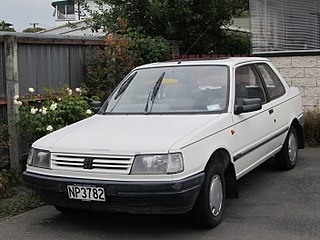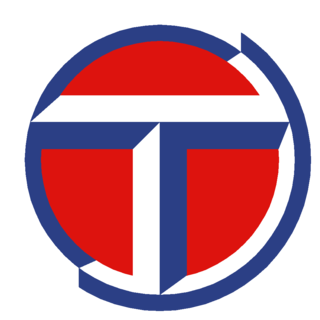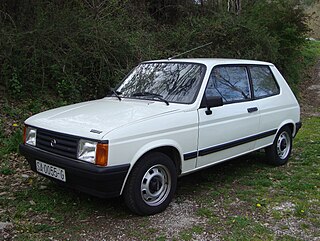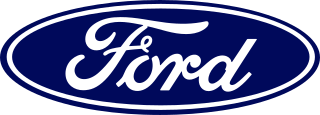
Peugeot is a French automobile brand owned by Stellantis.

Simca was a French automaker, founded in November 1934 by Fiat S.p.A. and directed from July 1935 to May 1963 by Italian Henri Pigozzi. Simca was affiliated with Fiat and, after Simca bought Ford's French subsidiary, became increasingly controlled by Chrysler. In 1970, Simca became a brand of Chrysler's European business, ending its period as an independent company. Simca disappeared in 1978, when Chrysler divested its European operations to another French automaker, PSA Peugeot Citroën. PSA replaced the Simca brand with Talbot after a short period when some models were badged as Simca-Talbots.

The Peugeot 405 is a large family car manufactured by the French automaker Peugeot from 1987 to 1997. Its production continued under license from outside Europe in Iran by Iran Khodro Company until 2020. It was voted European Car of the Year for 1988 by the largest number of votes in the history of the contest. About 2.5 million vehicles have been sold worldwide, both in left and right drive versions, as a saloon and estate. In early 2020, the 33-year production run of the Peugeot 405 was counted as the twentieth most long-lived single generation car in history."

The Rootes Group was a British automobile manufacturer and, separately, a major motor distributors and dealers business. From headquarters in the West End of London, the manufacturer was based in the Midlands and the distribution and dealers business in the south of England. In the decade beginning 1928 the Rootes brothers, William and Reginald, made prosperous by their very successful distribution and servicing business, were keen to enter manufacturing for closer control of the products they were selling.
Hillman was a British automobile marque created by the Hillman-Coatalen Company, founded in 1907, renamed the Hillman Motor Car Company in 1910. The company was based in Ryton-on-Dunsmore, near Coventry, England. Before 1907 the company had built bicycles. Newly under the control of the Rootes brothers, the Hillman company was acquired by Humber in 1928. Hillman was used as the small car marque of Humber Limited from 1931, but until 1937 Hillman did continue to sell large cars. The Rootes brothers reached a sixty per cent holding of Humber in 1932 which they retained until 1967, when Chrysler bought Rootes and bought out the other forty per cent of shareholders in Humber. The marque continued to be used under Chrysler until 1976.

The Peugeot 309 is a small family car that was manufactured between 1985 and 1994 in France, England and Spain by PSA Peugeot Citroën. It was originally intended to be badged as a Talbot and, as development progressed, to be called the Talbot Arizona.

The Hillman Avenger is a rear-wheel drive small family car originally manufactured by the former Rootes division of Chrysler Europe from 1970–1978, badged from 1976 onward as the Chrysler Avenger. Between 1979 and 1981 it was manufactured by PSA Peugeot Citroën and badged as the Talbot Avenger. The Avenger was marketed in North America as the Plymouth Cricket and was the first Plymouth to have a four-cylinder engine since the 1932 Plymouth Model PB was discontinued.

Talbot is a dormant automobile marque introduced in 1902 by British-French company Clément-Talbot. The founders, Charles Chetwynd-Talbot, 20th Earl of Shrewsbury and Adolphe Clément-Bayard, reduced their financial interests in their Clément-Talbot business during the First World War.

The Peugeot 206 is a supermini car (B-segment) designed and produced by the French car manufacturer Peugeot since May 1998 as a replacement to the Peugeot 205. Developed under the codename T1 and known for starting the wave of PF1 platform-based cars, it was released in September 1998 in hatchback form, which was followed by coupé cabriolet in September 2000, station wagon in September 2001, and a sedan version in September 2005, before being replaced by the 207 in April 2006.

The Talbot Horizon is a compact hatchback designed by Chrysler Europe and produced from 1978 to 1987. It was sold under the Simca, Chrysler and Talbot nameplates. The successor to both the Simca 1100 and Hillman Avenger, the Horizon adopted a front-wheel drive, transverse-engine layout.

The Talbot Tagora is an executive car developed by Chrysler Europe and produced by Peugeot Société Anonyme (PSA). The Tagora was marketed under the Talbot marque after PSA took over Chrysler's European operations in 1979. PSA presented the first production vehicle in 1980 and launched it commercially in 1981. The Tagora fell short of sales expectations, described as a "showroom flop" just a year after its launch, and PSA cancelled the model two years later. Fewer than 20,000 Tagora models were built, all of them at the former Simca factory in Poissy, near Paris, France.

The Simca 1307 is a large family car produced by Chrysler Europe and subsequently PSA Peugeot Citroën from 1975 to 1986. Codenamed 'C6' in development, the car was styled in the United Kingdom by Roy Axe and his team at Whitley, and the car was engineered by Simca at Poissy in France.

The Talbot Samba is a city car manufactured by the PSA Group in the former Simca factory in Poissy, France, and marketed under the short-lived modern-day Talbot brand from 1981 to 1986. Based on the Peugeot 104, it and the Talbot Express were the only Talbots not inherited from Chrysler Europe, engineered by PSA alone. It was also the last new Talbot car to be launched. Its demise in 1986 was effectively the end of the Talbot brand for passenger cars. Launched initially as a three-door hatchback, it was also for some time the only small car available in a factory-ordered cabrio body style, and the most economical car in Europe.

Chrysler Europe was the American automotive company Chrysler's operations in Europe from 1967 through 1978. It was formed from the merger of the French Simca, British Rootes and Spanish Barreiros companies. In 1978, Chrysler divested these operations to PSA Peugeot Citroën.

Peugeot S.A., trading as Groupe PSA was a French multinational automotive manufacturing company which produced automobiles and motorcycles under the Peugeot, Citroën, DS, Opel and Vauxhall brands. On 18 December 2019, PSA and Fiat Chrysler Automobiles (FCA) announced that they had agreed to the terms of a binding $50 billion merger. On 16 July 2020, both companies announced the new name for their merged operations, Stellantis. The deal closed on 16 January 2021. As of 2022, Stellantis is the fourth largest automaker by sales behind Toyota, Volkswagen Group, and Hyundai Motor Group.

The Chrysler 180 was the base name for a series of large saloon cars produced by Chrysler Europe. Resulting from joining the development efforts of Rootes Group and Simca, the car was produced from 1970 to 1975 in Poissy, France, and later in Chrysler's subsidiary Barreiros' factory in Spain. The Chrysler 180 was also the base for the medium-sized model built by Chrysler Australia, the Chrysler Centura.

Ford France is the French subsidiary of the American automaker Ford Motor Company, which existed as a manufacturer under various names between 1916 and 1954, when Ford sold the manufacturing business to Simca.

The Ryton plant is a former car manufacturing plant in Ryton-on-Dunsmore, England. Developed by the Rootes Group as a shadow factory in 1939 to produce aircraft engines for World War II; post war it became the headquarters of the group.
France was a pioneer in the automotive industry and is the 11th-largest automobile manufacturer in the world by 2015 unit production and the third-largest in Europe. It had consistently been the 4th-largest from the end of World War II up to 2000. It is 16% of sales of French manufactured products.
The Stellantis Poissy plant is a car plant belonging to Stellantis located in Poissy, Yvelines, France. It is dedicated to the manufacturer's Platform 1 cars, which are cars in the subcompact class, with an annual output of approximately 200,000 cars. Together with the R&D Centres at Carrières-sous-Poissy and at Vélizy, it is one of three major establishments that the company runs in the department.




















